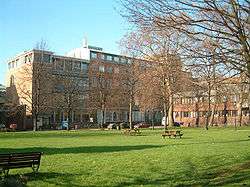Charterhouse Square




Charterhouse Square is a historic square in Smithfield, central London. It lies between Charterhouse Street and Clerkenwell Road, in the extreme south of the London Borough of Islington, just north of the City of London.
History
In 1371 a Carthusian monastery was founded by Walter de Manny on what is now the north side of the square. It was established near a 1348 plague pit,[1] which formed the largest mass grave in London during the Black Death, and tens of thousands of bodies were buried there. The name of the monastery, Charterhouse, was derived as an Anglicisation of La Grande Chartreuse, whose order founded the monastery.[2]
The Charterhouse was dissolved as a monastery in 1537, and in 1545 was purchased by Sir Edward (later Lord) North (c. 1496-1564) and transformed into a mansion house. Following North's death, the property was bought by Thomas Howard, 4th Duke of Norfolk, who was imprisoned there in 1570 after scheming to marry Mary, Queen of Scots. Later, Thomas Sutton bought the Charterhouse, and on his death in 1611, endowed a hospital (almshouse) and school on the site, which opened in 1614, supporting 80 pensioners (known as 'brothers'). The school for boys coexisted with the home for pensioners until 1872 when Charterhouse School moved to Godalming in Surrey. Following this, the Merchant Taylors' School occupied the buildings until 1933. The square also lends its name to a preparatory school which occupies a building overlooking the square.
In July 2011, English Heritage granted Grade II listed status to the "setted" road surface in the Square, which was laid down in the 1860s.[3]
Plague burials
In 2014 evidence of the large burial pit for plague victims dating from 1348–50, the time of the Black death, was discovered under the square by workers building the Crossrail project.[4] Subsequent analysis of DNA and isotopes from the skeletons of those buried revealed data about Londoners who fell victim to the pandemic, such as their birthplace, diet, and the fact that there were actually three periods of plague burials, from 1348, 1361 and the early 15th century as outbreaks recurred.[5]
Current use
The Charterhouse, an almshouse for retired men over the age of 60, is located on the north side of the Square on the old monastery site.
The Charterhouse Square campus of Queen Mary University of London is situated on the north-east of the Square, occupying the former school lands. The campus includes student accommodation and departments of Barts and The London School of Medicine and Dentistry: Barts Cancer Institute (BCI),[6] the Wolfson Institute of Preventive Medicine[7] and the William Harvey Research Institute (WHRI).[8] The BCI and the Centre for Cancer Prevention (CCP) within the Wolfson Institute also make up the Cancer Research UK Barts Centre of Excellence, together with Barts and the London NHS Trust.[9] The City of London Migraine Clinic is situated to the South-west of the Square.
Florin Court, a residential building in the Art Deco style built in 1936 by Guy Morgan and Partners, is located on the eastern side of the square. The building has a curved facade, roof garden and basement swimming pool.[10]
The independent preparatory Charterhouse Square School is on the south side of the square. Smithfield Market is to the south-west along Charterhouse Street.
Transport links
The nearest underground station to the Square is Barbican to the south-east. The Barbican bus stop is also near by.
In fiction
Florin Court was used as the fictional residence of Hercule Poirot, Whitehaven Mansions, in the 1980s TV series Agatha Christie's Poirot based on Agatha Christie's crime novels.[11]
References
- ↑ Palmer, Jason (March 15, 2013). "'Black Death pit' unearthed by Crossrail project". BBC News. Retrieved March 15, 2013.
- ↑ Charterhouse history accessed 19 Jun 2007
- ↑ "English Heritage grant protection to three Islington landmarks". Islington Tribune. 22 July 2011. Retrieved 10 January 2012.
- ↑ Black Death skeletons unearthed by Crossrail project By James Morgan, BBC News. 30 March 2014
- ↑ "London skeletons reveal secrets of the Black Death". Washington Post. 30 March 2014. Retrieved 30 March 2014.
- ↑ "Barts Cancer Institute". Retrieved 11 March 2014.
- ↑ "Wolfson Institute of Preventive Medicine". Retrieved 11 March 2014.
- ↑ "William Harvey Research Institute".
- ↑ "Barts Cancer Research UK Centre". Archived from the original on 11 March 2014. Retrieved 11 March 2014.
- ↑ Art Deco London accessed 19 Jun 2007
- ↑ Agatha Christie's Poirot (1989-) Screen online accessed 19 Jun 2007
External links
- LondonTown.com information
- The Charterhouse Square School website
- Charterhouse Square campus at Queen Mary University of London
- The City of London Migraine Clinic website
Coordinates: 51°31′15.35″N 0°05′55.35″W / 51.5209306°N 0.0987083°W
.jpg)